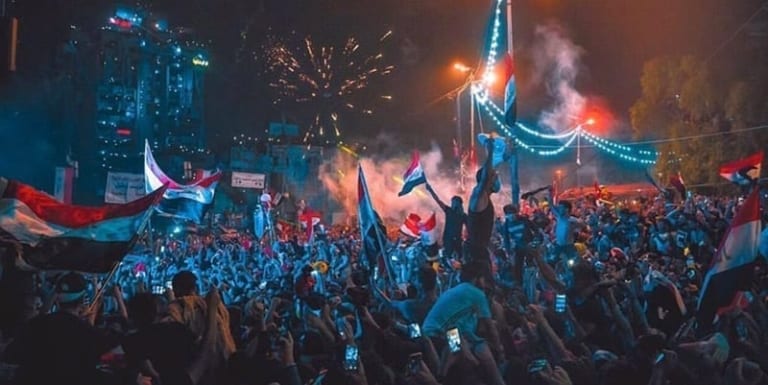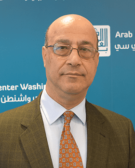
The ongoing protests in Iraq indicate that the country’s youth, who are overwhelmingly Shia, have become disillusioned with status quo politics of control by Islamist political parties and with government corruption and ineptitude. Following the 2003 American-led invasion, Iraq became a place of instability and chaos, with Iran-supported militias feasting on government largesse and national resources, specifically oil. A report by the Iraqi parliament says that $250 billion has been siphoned off public coffers since 2004. Iraq scored 18 out of 100 (with 0 as highly corrupt) on Transparency International’s Corruption Perception Index in 2018. Indeed, protests and opposition to the government of Prime Minister Adel Abdul-Mahdi, as a representative of the current state of affairs, were inevitable and imminent.
Over the last month, hundreds of thousands of protesters have braved security forces and militias and demonstrated in the streets to demand a new system of government that can address the many ills besetting Iraq’s society and its economy. They have been met with brutal force that so far has killed some 320 protesters and injured thousands more since October 1. But these protests are not solely the result of current conditions; years of government mismanagement, sectarian politics, problems of political patronage, graft, and the general collapse of good governance have also played a big role. Especially egregious has been the legacy of former Prime Minister Nouri al-Maliki, who was in office during 2006-2014. The last year of his reign witnessed the collapse of Iraq’s armed forces while ragtag contingents of Islamic State fighters swept northern and western Iraq and reached the outskirts of Baghdad.
Iraq’s protests today have gone beyond similar ones in years past. Tahrir Square in Baghdad erupted with calls for, among other things, reforming the constitution as unrepresentative of Iraqi realities, the resignation of the government, and the establishment of a salvation government that would pursue corrupt officials and others and prepare for new parliamentary elections to produce a legislative body that is not beholden to established interests. Protesters even pressed for the dissolution of Iraq’s Independent Elections Commission and the formation of a new one that could revise the electoral law. They also pushed for a new law for political parties that would prohibit their establishment on a sectarian basis.
The Return of Nationalist Consciousness
The long years of Maliki’s rule and that of his successors Haidar al-Abadi and Adel Abdul-Mahdi created a toxic sectarian political atmosphere that resulted in a near-complete collapse of cross-sectarian cooperation between the Shia and Sunni communities. This period also produced the unchallenged control of Islamist parties such as Maliki’s Daawa and others that established their own armed militias, many of them under the umbrella of the Popular Mobilization Forces. What is going on today in Baghdad and the southern Shia-majority governorates is a rebellion against these parties and militias as well as against the Iranian presence in the country. The protesters are calling for a return to nationalist politics that eschews sectarianism and divisive politics. Indeed, demonstrators in the Shia holy city of Karbala even attacked the Iranian consulate there; they took down the Iranian flag and hoisted the Iraqi flag in its place. The release by The New York Times and The Intercept of leaked documents about Iran trying to embed itself in Iraqi affairs is likely only to increase the protesters’ demands for ending the Islamic Republic’s influence in their country.
Preceding and accompanying these protests are social and political manifestations of a different attitude toward extant conditions, such as:
- A notable change in the discourse of the Shia religious leadership. For example, the marjaiyya of Ayatollah Ali Sistani is now highly critical of the political class and its policies and behavior; Sistani has supported deep reforms in the political system in response to the protests.
- A steady decline of participation in parliamentary elections since 2006, from about 80 percent in 2006 to almost 45 percent in 2018. In addition, a large number of entrenched incumbents lost their seats in 2018.
- A noticeable decline in sectarian identification matched by an appreciable increase in nationalist sentiment.
- A clear rejection of Iranian influence in the country. This has been seen on city streets not only this time around but also in other bouts of protest in previous years.
- The eruption of a leaderless youth movement that decided to break its allegiance to a dominant Shia clerical class and to the wider political class in general. The nature of the protests has helped to sustain and strengthen the movement as the government increased its repression.
- The widening of the scope of demands from the economic and social to the political realm whereby the protesters would be satisfied by no less than the resignation of the prime minister and an end to the role Iran plays in the country.
What was very important in this round of protests was the active participation of Iran’s Supreme Leader Ali Khamenei. He denounced the protesters as being paid by foreign powers––the United States and Israel. This had a negative impact on the street and on the demonstrators, who responded by raising the threshold of their call to put an end to Iranian influence in Iraq. In fact, the attack on the Iranian consulate in Karbala was emblematic of the fissure between the Iraqi Shia community––which had been perceived as a natural environment for Iran––and the Islamic Republic itself.
Equally important has been the seeming absence of Iraq’s Sunnis––as a community dissatisfied with the politics of the last decade and a half––from the protests. In a sense, Sunnis may have decided not to participate––as Sunnis––in order to deny Shia politicians and militias the opportunity to claim that the entire protest movement has been fomented by the Baath Party or supporters of al-Qaeda in Iraq and the Islamic State. If this is true, then the Sunnis may have spared the protesters the negative implications of being associated with extremists and terrorist groups. On the other hand, Sunnis have also escaped whatever potential repercussions and brutal retaliation against them and their areas, as was the case under Maliki.
Notably, the three Kurdish-majority provinces in the north––Sulaymaniya, Irbil, and Dahuk––have seen no protests. For its part, the Kurdistan Regional Government expressed its support for the protests, seeing them as justified, but rejected the resignation of Abdul-Mahdi’s government and the amending of the constitution which, to the KRG, protects the region’s rights in a federal Iraq. Still, people of the region have the same grievances as the rest of Iraq’s population and complain about rampant corruption, monopolization of power, patronage, and suspicious policies that, at any rate, may later lead to similar protests.
What May Be Expected?
What is happening in Iraq today was simply unexpected until just a short while ago. Iraq’s youth have almost unanimously fanned out in the streets to protest intolerable conditions endemic in the political and economic systems since the American-led invasion of 2003. What is clear and encouraging is that Baghdad’s Tahrir Square is crowded with a non-sectarian and cross-ethnic cohort of young Iraqis demanding change of a corrupt and divisive political system. They indeed possess a nationalist Iraqi identity and agenda, one that does away with old and reactionary ideologies and with an Iranian influence that they feel is trying to revive an old Iranian dream of controlling the Arab East down to the Arabian Peninsula.
Considering the steadfastness of Iraq’s protesters and the (so far) failed official and militia response, the events in Iraq today present a unique case in a vital region. They are likely to have a palpable impact on Iraq in the years to come.
Domestically, it is likely that there will be a re-resurgence of Iraq’s national identity that will surpass all other sectarian and local identities. Accompanying this resurgence will be a retrenchment of the role of religious institutions, especially that of the Shia marjaiyya as a source of political authority. Moreover, the reluctant Kurdish-majority region will probably join others in rejecting the dominance of specific exclusivist groups that have lived on rampant corruption and institutionalized oppression.
There should be an expectation that a new young leadership will emerge from today’s protests to impose a rational and wise approach to governance in Iraq. This leadership will insist on a new constitution to be ratified in a referendum. Such a national charter will reject parties established on religious and sectarian bases and will include the necessary guarantees for equal citizenship and responsibility.
Regionally, it is expected that the future will witness a strong opposition movement in Iran that could force serious political changes. Indeed, it is likely that ongoing protests in Iran are also an outcome of a contagion from Iraq and Lebanon, although a hike in the price of gasoline may have been their direct cause. The Iraqi protest movement has the potential to collapse the Iranian scheme for regional hegemony. Lebanon’s current protest movement also indicates that the same outcome is likely, with a new political arrangement taking hold that does away with sectarianism and Hezbollah. In Yemen, a similar process may become possible when the country finds its civic peace and Yemeni factions agree on a compromise. Developments in Iraq, Lebanon, and Yemen are likely to lead to a similar outcome in Syria, whose regime is dependent now on blanket support from Iran. Finally, a retrenchment of Iranian interference in the eastern Mediterranean can only result in a stronger Arab political order, one that can redress the present imbalance with Israel as well as the question of Palestine.
Internationally, a stronger Iraq and a receding Iranian influence are likely to annul or lessen the need for an alliance with the United States or other powers, and this will diminish the danger of confrontations in the Arab region. With the United States relinquishing the reason for its engagement in the Gulf and Arab regions, there may be a renewed and healthy competition between the United States, Russia, China, India, and others. As it feels less prone to conflict and instability, the Arab world will likely embark on a purposeful mission of economic, social, and political renewal.


